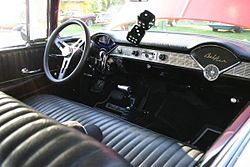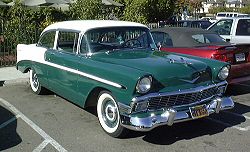Chevrolet Bel Air
| Chevrolet Bel Air | |
|---|---|
 | |
| Manufacturer | Chevrolet |
| Parent company | General Motors |
| Production | 1953-1975 (U.S.) 1953-1981 (Canada) |
| Class | Full-size |
| Layout | FR layout |
The Chevrolet Bel Air is an automobile series produced by the Chevrolet division of General Motors from 1953–75. From 1950–52, hardtops in Chevrolet's premium Deluxe model range were designated with the Bel Air name, but it was not a distinct series of its own. The Bel Air continued in production in Canada through the 1981 model year.
History
1953–1957
| First generation | |
|---|---|
 | |
| Production | 1953-1957 |
| Body style(s) | 2-door hardtop 4-door hardtop 2-door convertible 4-door sedan 2-door coupe |
In 1953 Chevrolet renamed its series and the Bel Air name was applied to the premium model range. Two lower series, the 150 and 210, also emerged.
The 1953 Chevrolet was advertised as "Entirely New Through and Through," due to the restyled body panels, front and rear ends. However, essentially these Chevys had the same frame and mechanicals as the 1949-52 cars. The Bel Air series featured a wide chrome strip of molding from the rear fender bulge, to the rear bumper. The inside of this stripe was painted a coordinating color with the outside body color, and "Bel Air" scripts were added inside the strip. Lesser models had no model designation anywhere on the car, only having a Chevy crest on the hood and trunk. Bel Air interiors for 1953 had a massive expanse of chrome across the lower part of the dashboard, along with a de luxe Bel Air steering wheel with full chrome horn ring. Carpeting and full wheel covers rounded out Bel Air standard equipment. For '54, the Bel Air stayed essentially the same, except for a revised grille and taillights. During these years, there were two engine choices, depending on the transmission ordered. Both engines were "Blue Flame" inline six cylinder OHV engines. featuring hydraulic valve lifters and aluminum pistons. The 115 hp (86 kW) engine was standard on stickshift models, with solid lifters and splash plus pressure lubrication. Powerglide cars got a 125 hp (93 kW) version which had hydraulic lifters and full pressure lubrication. '54 cars with stick shift got the 1953 Powerglide engine. During 1953-54, Bel Airs could be ordered in convertible, hardtop coupe, 2- and 4-door sedans, and, for 1954, the Beauville station wagon which featured woodgrain trim around the side windows. Power steering was optional for 1953; 1954 added power brakes, power seat positioner and power front windows.
In 1955, Chevrolets gained a V8 engine option. The new 265 cubic-inch V8 featured a modern, overhead valve high-compression, short stroke design that was so good that it remained in production in various forms, for many decades. The base V8 had a two-barrel carburetor and was rated at 162 horsepower (121 kW), and the "Power Pack" option featured a four-barrel carburetor and other upgrades, yielding 180 brake horsepower (130 kW). Later in the year, a "Super Power Pack" option added high compression and a further 15 brake horsepower (11 kW). Most enthusiasts today associate the Bel Air and the V8 together, even though neither was dependent on the other. That year, Chevrolet's full-size model received new styling that earned it the "Hot One" designation by enthusiasts. Unlike Ford and Plymouth, Chevrolet's styling was considered crisp and clean. Bel Airs came with features found on cars in the lower models ranges plus interior carpet, chrome headliner bands on hardtops, chrome spears on front fenders, chrome window moldings, and full wheel covers. Models were further distinguished by the Bel Air name script in gold lettering.
The '55, '57, and especially '56 Bel Airs are among the most recognizable American cars of all time; well-maintained examples (especially Sport Coupes and convertibles) are highly sought after by enthusiasts. Roomy, fuel-efficient, and with tastefully restrained use of tail fins and chrome, they are seen by many as vastly superior to the oversized and overdecorated full-size models that would roll out of Detroit for the next 20 years.
From 1955–57, production of the two-door Nomad station wagon was assigned to the Bel Air series, although its body and trim were unique to that model. Prior to becoming a regular production model, the Nomad first appeared as a Corvette-based concept vehicle in 1954. Chevrolet has since unveiled two concept cars bearing the Nomad name, most recently in 1999. 1956 saw the introduction of the pillarless four-door model, called Sport Sedan and available in both Bel Air and Two-Ten models.
1958: Impala, Bel Air, Biscayne, and Delray
| Second generation | |
|---|---|
 | |
| Production | 1958-1965 |
| Assembly | Arlington, Texas Oshawa, Ontario, Canada |
| Body style(s) | 4-door sedan 2-door coupe 2-door convertible 4-door station wagon |
For 1958, Chevrolet models were redesigned to be broader, longer and heavier than their 1957 predecessors. The Impala now became the premium Chevrolet, followed by the mid-range Bel Air. For the budget conscious, the Biscayne, (formerly the 210) and the Delray (formerly the 150) completed this model years family oriented and utility offerings.
Chevrolet's design for the year fared better than its other GM brethren, and lacked the overabundance of chrome found on Pontiacs, Oldsmobiles, Buicks and Cadillacs. Complementing Chevrolet's front design was a broad grille and quad headlights; the tail received a fan-shaped alcove on both side panels, which housed dual tail lights.
The Bel Air also gained a halo model in 1958, the Impala, available only as a hardtop coupe and convertible in its introductory year. Impala styling followed the basic lines of the other Chevrolet models but received special styling cues including a different roof line, a vent above the rear window, unique side trim, and triple tail lights housed in slightly broader alcoves.
Despite being a recession year, consumers made Chevrolet the No. 1 make of automobile (beating Ford, which held the title in 1957) and the Bel Air was at the core of Chevrolet's popularity. With its wide variety of body styles and models, Bel Airs could be optioned with almost every conceivable luxury within the Chevrolet line. The Nomad station wagon name also reappeared in 1958 when the vehicle bowed as the premium four-door Chevrolet station wagon, lacking the unique styling of the 1955-57 Nomads. Most Chevrolet station wagon models had two tail lights housed in abbreviated alcoves, which were made smaller to accommodate the rear gate. An exception was the Yeoman .
1959–1965: Mid-range model
In 1959, Chevrolet elevated the Impala to top-line status, making the Bel Air the mid-level model. The Biscayne replaced the discontinued Delray as the least expensive full-size Chevrolet model.
From 1960, Bel Airs and Biscaynes could easily be identified by their use of two taillights per side; the Impalas had three taillights per side. Also, the Bel Air had more interior and exterior brightwork than the Biscayne. Many of the same options and accessories that were available on the Impala were also available on the Bel Air.
Of noteworthy importance is the 1962 Bel Air Sport Coupe, the last year a Bel Air hardtop was offered in the USA. This model featured the "bubbletop" roof from '61, and was popular with drag racers, who ordered this car with Chevy's new-for-'61 409 cubic inch "W-block" V8 with up to 409 bhp (305 kW), a special package including aluminum body panels, heater delete, and four-speed manual transmission. A car with this configuration today is a valuable collector vehicle that commands a big premium over other '62 Chevys, including the classy Impala SS.
1966–1975: Low-line model
| Third generation | |
|---|---|
 | |
| Production | 1966-1970 |
| Assembly | Arlington, Texas Oshawa, Ontario, Canada |
| Body style(s) | 4-door sedan 4-door station wagon 2-door coupe |
| Platform | B-body |
| Related | Chevrolet Impala Buick LeSabre |
| Fourth generation | |
|---|---|
 | |
| Production | 1971-1975 (U.S.); 1971-1976 (Canada) |
| Assembly | Arlington, Texas Oshawa, Ontario, Canada |
| Body style(s) | 4-door sedan 4-door station wagon 2-door coupe |
| Platform | B-body |
| Transmission(s) | 3-speed manual (standard, 1971-1973 on all six-cylinder cars), Turbo-Hydramatic (optional 1971-1973 on six-cylinder cars; standard on V-8 powered cars from mid-1971 onwards) |
| Related | Chevrolet Impala Buick LeSabre |
By the late 1960s (with the introduction of the Caprice), the Bel Air and its Biscayne stablemate were primarily marketed to automotive fleet customers. However, the Bel Air remained available to private customers who sought a basic, no-frills full-sized car that was slightly better trimmed than the low-line Biscayne. When the Biscayne was discontinued after 1972, the Bel Air was demoted to the low-level model.
A six-cylinder engine and three-speed manual transmission remained standard equipment through the 1973 model year; the automatic transmission had been the sole transmission choice on V-8-powered Bel Airs since the spring of 1971. Only about 1,400 cars were built with the inline six in 1973, and the engine and the outdated stick shift transmission were shelved by the end of the model year. All Bel Airs built in 1974 and 1975 listed a 350 two-barrel V8 engine and Turbo-Hydramatic transmission as standard.
All U.S.-market Bel Airs sold between 1970 and 1975 were four-door sedans or station wagons. However, a Bel Air sport coupe - based on the Impala, but with Bel Air-level trim - was sold in Canada from 1970 to 1975.
Most other changes to the Bel Air during its final years were identical to the more expensive Caprice and Impala lines. For instance, the 1975 models had a new roofline and came with new dashboard, radio and climate control graphics (the speedometer read up to 100 mph (160 km/h), and had smaller numbers for kilometers per hour). In addition, customers could buy their 1975 Bel Air with two new options: an Econominder gauge package (which included a gauge that monitored fuel economy, due in part to growing demands for fuel economy) and intermittent wipers.
The last Bel Airs for the United States were manufactured for 1975.
1976-1981: Bel Airs in Canada
| Fifth generation | |
|---|---|
| Production | 1977-1981 |
| Assembly | Oshawa, Ontario, Canada |
| Body style(s) | 2-door coupe 4-door sedan 4-door station wagon |
| Platform | B-body |
| Transmission(s) | Turbo-Hydramatic |
| Wheelbase | 116 in (2946 mm) |
| Related | Chevrolet Caprice Chevrolet Impala Pontiac Safari Pontiac Bonneville Pontiac Parisienne Pontiac Catalina/Laurentian Oldsmobile 88 Oldsmobile Custom Cruiser Buick LeSabre Buick Estate Cadillac Fleetwood Cadillac Brougham |
Chevrolet's Canadian affiliate continued the Bel Air as its lowest-priced full-size car through the 1981 model year.
2002 Bel Air show car
In 2002, a concept Bel Air convertible was shown at the North American International Auto Show. It featured many styling and design cues from the legendary 1955–57 models, and had tail lights very similar to the Ford Thunderbird. So far, General Motors has shown no interest in producing such a car.
Bel Airs in Popular Culture
Chevrolet Bel Airs have been featured prominently in several films. These include Dr. No (1962), American Graffiti (1973), Two-Lane Blacktop (1971), Thunder and Lightning (1977) and A Perfect World (1993). In the Danish "Olsen_Banden" (The Olsen Gang, 1968-1998) film series, in 13 out of 14 movies, the gang drives an extremely worn and rusty Bel-Air.
Alternative-country group Old 97's have a song called "Bel Air", found on their album Wreck Your Life.























![Validate my RSS feed [Valid RSS]](valid-rss-rogers.png)















































































1 ความคิดเห็น:
This vehicle doesn't come close to the 1957 Bel Air
แสดงความคิดเห็น